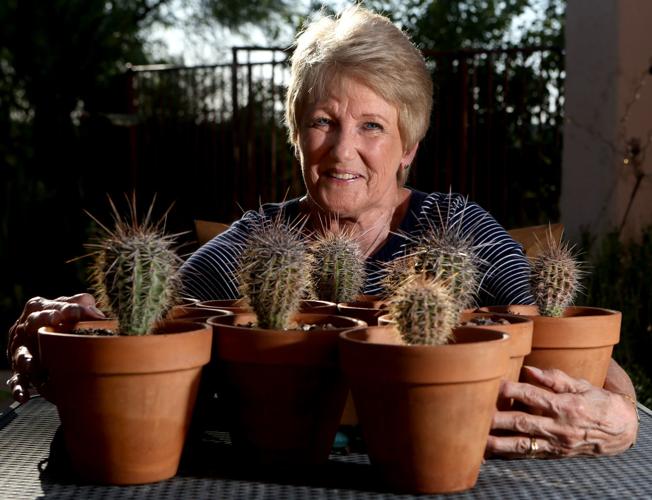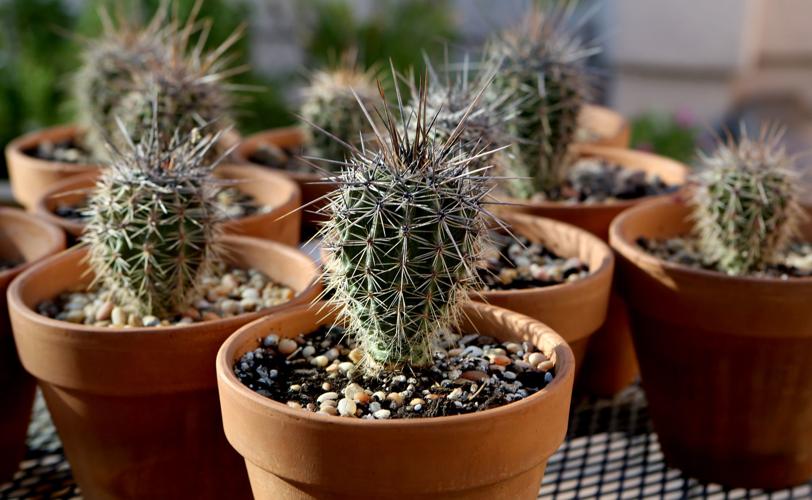Nancy Freeman learned to be a brave gardener — by growing 11 saguaros .
Freeman, an accountant, made a bold move 10 years ago and took some of the thousands of seeds produced by the one-armed saguaro at her employer’s office.
“When I started working there, there was a single saguaro that had no arms,” recalls Freeman, who has worked for 30 years at an eye-care practice.
“I saw the fruit open,” she says of that 2008 day, “and realized there were black seeds inside.”
She took a couple of fruit to her northwest-side home, read up on how to make the seeds sprout and sowed a few in several 2-inch pots. In 16 days tiny two-leaf shoots emerged.
Then she took a series of wrong turns because she was afraid the young shoots would die.
“My biggest mistake was that I would baby them too much,” she says.
It started by wanting to protect the shoots from the elements.
She covered a window pane in her office with a white sheet of wrapping paper left over from a Godiva chocolates box. She set the seed cups into larger clay pots and put them on a nearby shelf.
She methodically used a syringe to water the pots every 10 days. In order to remember when to water, she wrote “10,” “20” and “30” on different sides of each pot. Once she watered on that date, she rotated the pot to the next number.
Lesson No. 1: Cacti need to have the same side face the same direction to protect all sides from sun and frost.
Four years later, she saw the plants, about three-quarters of an inch tall, weren’t nearly as big as she’d seen at nurseries and in pictures. She was told by a University of Arizona plant expert that they needed to be separated from each other.
Lesson No. 2: Seedlings will slow growth when crowded in pots.
“I was terrified to do this,” she says. She used tweezers to gingerly pull each plant out and give it its own 6-inch clay pot.
In 2014, Freeman had to bring the cacti home during an office move. It was the first time they would be outside. They lived in a rabbit cage on the shaded patio for two years to keep critters away. She brought them inside for the winter.
Lesson No. 3: Growing saguaros need sun.
“They were not getting the sunlight that they needed,” she says.
Now the 11 surviving saguaros sit in pots on a table in a sunny patio. A red dot on the pot always faces north.
Freeman waters them every weekend during the heat and dryness of early summer, but cuts way back at other times of the year.
A scare over one diseased cactus has turned out to provide a good gauge on how her constant attention actually stunted the growth of the saguaros.
The UA plant expert warned her that one cactus with a black splotch probably was infected with a fungus. She was advised to throw it out before it infected the others.
“I’m like, ‘no,’” she says. “I stuck it in this pot” — she points to a 10-inch container that also holds an echinocereus–“and ignored it.” That saguaro now is a bit bigger than all the others, which range from about 4 to 6 inches high.
That’s smaller than what she sees in nurseries. But it’s much bigger than a wild specimen, which, after 10 years, may be shorter than 2 inches, according to information from the Arizona-Sonora Desert Museum.
Right now, Freeman’s cacti look like dark green, spiky, bulbous hot air balloons. “They’ve come a long way in the last four years,” Freeman says proudly.
Emboldened by her experience, Freeman has gone on to grow Peruvian apple cactus, oleander, Texas umbrella tree and golden barrel cacti from seed.
But her saguaros are most precious. At 71 years old, Freeman expects that she won’t see them flower. That could take another 40 years. Friends who have followed Freeman’s saguaro adventure will inherit them. It says so in her will.
And after 10 years, she’s realized that they will survive even with her nurturing missteps. Says Freeman: “They really are pretty strong little guys.”






